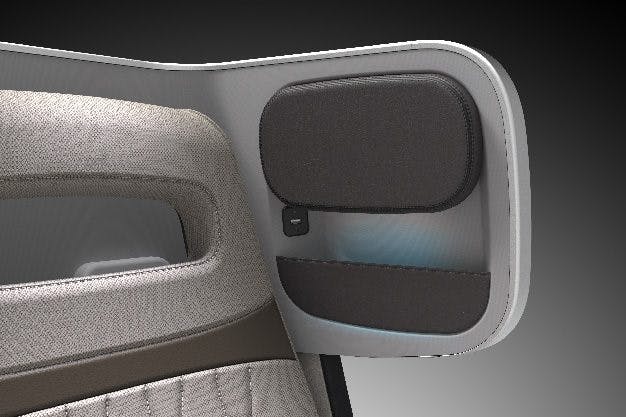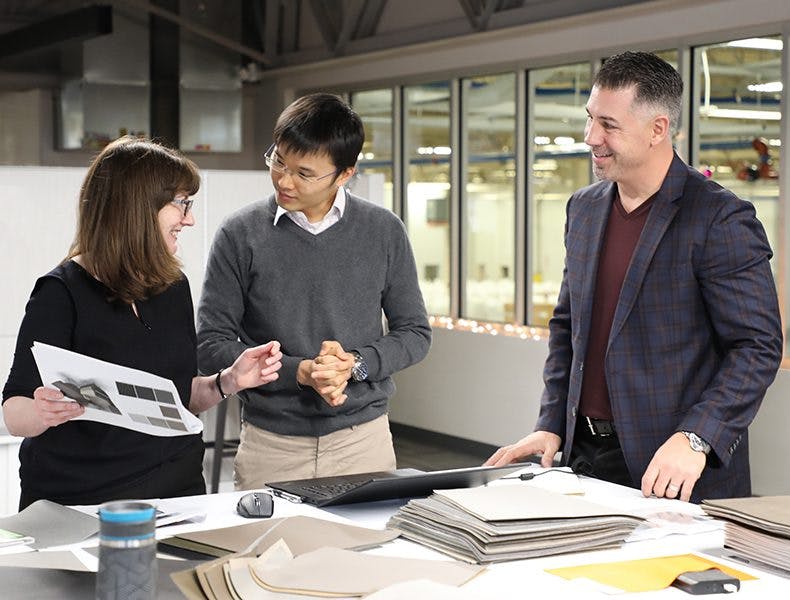
RedCabin brings industry leaders together to innovate for the future passenger experience in an aircraft cabin.
The BUTTERFLY® 2.0 Seating project is a perfect example of bringing disruptive ideas to the aviation interiors market with partners Butterfly Flexible Seating Solutions, TAPIS, MGR Foamtex, Studio Catherine Barber and SEKISUI KYDEX.
AN INDUSTRY LEADING PARTNERSHIP
BUTTERFLY® is a flexible seating solution that allows instant transformation between premium economy/ regional business class, and long-haul flatbed suites. Lars Rinne, BUTTERFLY® Co-Founder and Commercial Director and James Lee, Co-Founder and Creative Director began their journey in 2014 after winning the highly coveted Crystal Cabin Award with the initial design of the concept.
In 2019, after spending two years traveling the globe collecting customer feedback with full-size mockups of the concept, they were ready to take BUTTERFLY® to the next level: to build an enhanced version of their prototype featuring flight ready materials, structure, and design.
During the December 2019 Red Cabin Aircraft Cabin Innovation Summit, Rinne met industry leaders and developed partnerships to achieve the goals of an enhanced prototype. Their partnership was announced at the end of the event.
“With our partners’ know-how, we can put BUTTERFLY® in the position to be competitive with both standard recliners as well as business class lie-flat suites. We are in the process of creating a seat that we are happy to sell, airlines are thrilled to buy, and passengers are delighted to sit in,” said Rinne.
This sparked the beginning of a journey through the SEKISUI KYDEX appLab™ and designLab® Innovation Centers, where engineering and design meet.
WHERE INNOVATION BEGINS
Rinne and Lee visited the appLab™ innovation center to explore thermoplastics. They were introduced to the material differences and capabilities, processing options, and how to design parts for manufacturing. The unique and flexible design of BUTTERFLY® 2.0 requires customization of each part of the seat. With a design more complicated than a traditional seat, both BUTTERFLY® and the appLab™ were up for the challenge.
SEKISUI KYDEX developed their Innovation Centers, as a place to explore the possibilities. To inspire their visitors, every interaction is curated to help customers reach their goals. These service areas are not just focused on products and process but are instead designed for paths of discovery and exploration. While innovative solutions are expected to come from these Innovation Centers, the focus is on the experience of creating them rather than finding one specific solution.
“Some who visit SEKISUI KYDEX come for design and others come for engineering, the two tenets of the designLab® and appLab™ Innovation Centers. But in every visit, there is the unknown, discovered as everyone collaborates. Our teams learn from our visitors as much as our visitors learn from us. All that’s needed is curiosity,” said Bernadette Chupela, Customer Experience Manager at SEKISUI KYDEX.
The first step in the BUTTERFLY® 2.0 project partnership was to bring James Lee from BUTTERFLY®, Catherine Barber, Owner of Studio Catherine Barber, Jason Estes, Vice President of Global Sales & Marketing for Tapis and SEKISUI KYDEX to the table for 3 days of innovation, design, and exploration.
“We are excited to help innovative startups like BUTTERFLY® bring their disruptive ideas into the market,” says Ronn Cort, President and COO of SEKISUI KYDEX, speaking at Red Cabin’s Aircraft Cabin Innovation Summit in London. “That’s the mission of our appLab™, an innovation center where ‘what ifs?’ become fully-fledged projects.”

THE DESIGNLAB® EXPERIENCE
Starting in the designLab®, Barber and Lee presented their CMF design ideas to kick off the collaboration. They shared inspiration of earth tones found in textiles, architecture, and bespoke environments. Estes provided stacks of textiles in a range of textures and hues for comparison.
Taking the colours of the textiles and the CMF inspiration boards, the designLab color technicians create a range of colour iterations for consideration.
Teams enter a state of flow as the project progresses. Ideas bounce around conference rooms where sketches, swatches, and phrases cover the whiteboards.
Pieces of fabric, thermoplastics, and timelines float on moving bulletin boards, visualizations of a project taking shape. Everything a design team needs is at their fingertips, from advanced equipment, to the physical and mental space to innovate, which sometimes creates “happy accidents.”
“That’s the joy of it, those happy accidents would not happen otherwise. It’s that magical element. It’s easier to be bold when you’re here. If I send you a written brief, I’m really conscious. I don’t want you making endless iterations that won’t work because of my brief. I feel a real responsibility to limit that sampling to be very carefully targeted. But if I’m here with you, we can negotiate. ‘Can we try that?’ or ‘Do we have time?’ become questions that can be asked and answered quickly, moving the project forward in creative ways,” said Barber.
Being on-site also allowed the team to explore ways of using Infused Imaging™. Infused Imaging™ technology is a Crystal Cabin Award winning, proprietary process that embeds imagery into thermoplastic material. Designers, seat manufacturers, and airlines can create bespoke environments using colour, images, and texture without sacrificing strength and durability.
Part of Barbers inspiration featured designs found in architecture. SEKISUI KYDEX Senior Graphic Artist, Becky Gallup digitized the inspiration and worked with Barber to test iterations of the design in real time. During the three day period, Gallup took Barber’s feedback and modified design colours, overlayed multiple visual textures, and explored design direction.
Because they were able to design, produce sheet, and thermoform the material all in house, Barber could see how the iterations performed and choose the best one for her vision. Usually designers must traverse the universe through trips to the customer, textile house, materials manufacturer, seat OEM, and more.
Materials and creative briefs are sent all over the world and can end with forcing a designer to settle or asking suppliers to send more options.
“The Innovation Centers (appLab™ and designLab®) accelerated the trim and finish selection process with space to truly collaborate on this project together with our partners. Without these resources, this project would have taken weeks instead of hours. I was amazed at how quickly the team incorporated feedback to develop the samples. Having these tools and resources allowed us to put the final touches on the CMF process for BUTTERFLY® 2.0 Seat,” said Estes.
Part of what made this project successful, was the team’s preparation for virtual collaboration following their departure. Utilizing the X-Rite Total Appearance Capture System (TAC™), the team scanned in materials of interest and loaded digital renderings of BUTTERFLY® 2.0.
This allowed the team to use KeyShot® to digitally apply materials, textures and colours after the visit concluded. While colour, materials and finish were being explored in the designLab®, Lee and the team were exploring part geometries and thermoforming in the appLab™. They were preparing for the appLab™ to create more than 30 parts for the final prototype from Lee’s designs.
THE APPLAB™ EXPERIENCE
Lee had already spent some time with the appLab™ and was informed on thermoplastics. During this second visit, Lee and the team looked at individual part geometries to discuss how the parts would connect and perform. The appLab™ engineers made recommendations on where pressure forming would be better than vacuum forming and provided modifications to the part geometries to adjust undercuts, split lines, and hidden edges.
The part design was unique because, compared to a traditional seat, the BUTTERFLY® suite is designed for multiple seat configurations.
To accommodate the variety of shapes and functionality of the suite, over 30 thermoplastics parts would be required.
“Being able to design a part in CAD, mill the tooling by CNC, and seeing it thermoformed right in front of my From Left to Right: Shawn Gum, Lars Rinne, and James Lee eyes, all in the same place and on the same day really helped me as an industrial designer to understand the capabilities and limitations of vacuum and pressure forming. It enabled me to design parts that are more optimized and cost-efficient.” said Lee.
Much of the appLab™ experience then transitioned to virtual collaboration. Lee continued to perfect the parts designs.
SEKISUI KYDEX worked with partners Orange Packaging and Catalysis Additive Tooling to make the part molds.
It is through relationships with partners like Catalysis that can 3D print molds that SEKISUI KYDEX was able to move quickly with parts arriving in under 48 hours.
While the molds were being produced, Shawn Gum, Applications Engineer, SEKISUI KYDEX, made the wooden frame to retrofit the parts. Lee provided engineering drawings for the aluminum frame that would ultimately be used in the final prototype. Gum used these drawings to duplicate a frame out of wood meeting the incredible short lead time required.
“We used the engineering drawings provided to create 3D part models to assemble the frame. These parts were cut using our Thermwood 5-axis CNC router. The CNC cut very accurate parts for the frame to ensure our formed parts fit as they were intended to. There were many parts with overlapping joints and our frame allowed us to confirm they fit properly, and the joints lined up.” said Gum. “With the aggressive timeline the parts had to fit correctly to avoid losing time shipping parts back and forth. By actively collaborating with the BUTTERFLY® team we were able to produce many different parts within a short period of time.”
Once the molds were received, the appLab™ engineers formed each KYDEX® Thermoplastic part for the prototype. These parts were then trimmed using a CNC router.
The appLab™ engineers inspected each part and worked to retrofit them to the wooden frame. Because there were so many intricate and unique parts for the design, it was important that the team have a frame to test part fit on. Because the frame was made from wood and was just a test frame, the holes for part mounting were not in the frame. This meant retrofitting the parts would require taping parts to the frame for fit adjustment. By retrofitting them in-house, they could make adjustments to the parts before sending them to BUTTERFLY®.
Once the appLab™ team confirmed the parts were accurate, they shipped them to BUTTERFLY® to be added to the final prototype. BUTTERFLY® had their aluminum frame ready and retrofitted the parts for their final prototype. Because this frame was more accurate, they were able to locate the areas where part adjustment was required. This was minimal as the appLab™ had been able to identify some of these potential inconsistencies with the use of their wooden frame.
THE FUTURE OF BUTTERFLY® 2.0 AND KYDEX® THERMOPLASTICS
All of this work, from design to construction, was done between December 2019 and March 2020, giving meaning to the phrase ‘rapid prototyping’. The goal was to launch the seat at the 2020 AIX Expo. Unfortunately, the COVID-19 Pandemic hit in March of 2020, which stalled the project.
SEKISUI KYDEX and BUTTERFLY®, opted to use the next several months to refine parts on the project and introduce new technologies. KYDEX® surfaceGrip™ (anti-slip, soft touch cap) and KYDEX ION Technology™ (premium antimicrobial formulation) are just two of the materials being explored as potential additions to BUTTERFLY®2.0.
SEKISUI KYDEX is excited to continue to provide an innovation playground that combines high-tech equipment and a team of experts with a passion for creative solutions. At the SEKISUI KYDEX Innovation Centers, traditional methods are challenged, inviting collaboration between unlikely partners with the courage to disrupt the norm. The only limitation is one’s imagination.